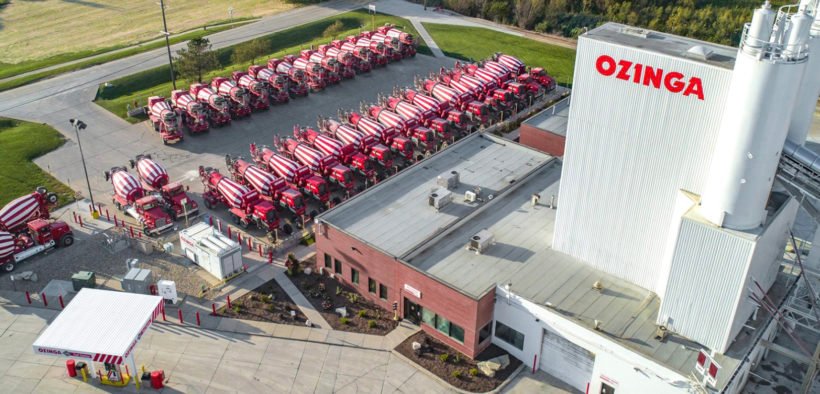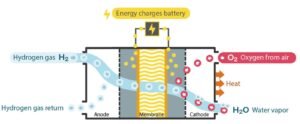

Ozinga is one of the nation’s largest family-owned and oldest construction materials companies.
Is it better to take a risk and try tojump-start a trend, or to cautiously follow the lead of others? While many ofus at this moment feel like we’re merely reacting to trends outside ourcontrol, there are certainly times when it makes sense to take a chance and getout in front of the rest of the field.
That’s what Ozinga, one of the nation’s largest family-owned and oldest construction materials companies, did a few years ago. The concrete industry is a historically slow adopter of new technologies. However, Ozinga’s fourth-generation leadership, which had recently formed a six-person research and development team, felt the time was right to introduce a new concrete product to its market that would help reduce emissions of carbon dioxide (CO2).

“We’re always doing new things withtechnology and the materials,” notes Ryan Cialdella, vice president of R&D. Ozinga wasan early adopter of CarbonCure,a technology developed in Canada that embeds CO2 into concrete while alsoimproving its compressive strength.
How far ahead of the curve was Ozinga withits embrace of CarbonCure? Well, not only was it the only company offering thistype of product in Illinois and south Florida at the time, but most of its customersweren’t even asking for it — yet.
But Ozinga knew CarbonCure had legs,and its leadership didn’t want to wait for the industry to catch up. “It wasn’tclients at the time” who were asking for it, Cialdella explains. “It was more of abusiness decision, as partof our mission to continue to find ways to produce more sustainable concrete,as well as ‘let’s look at what the industry is going to need in the near future.’”But bringing engineers up the learning curve so they would feel comfortable specifyingCarbonCure in their new projects required some old-fashioned persistence onOzinga’s part.
“It was a challenging task,” Cialdella says. “Some wouldbe interested in it, right? But then you go in there and talk to them and then theyjust would never put it in a job. [The attitude was] ‘Oh, that’s cool.’ Youknow, ‘keep us up to date on where it’s going,’ because the concrete industryis just such a conservative industry.”
That began to change for Ozinga whenCarbonCure was specified on some major projects, including a flagshipMcDonald’s location in downtown Chicago in the late teens. Use of CarbonCureallowed McDonald’s to embed about30,000 pounds of CO2 in the concrete on-site, the equivalent of a 16-acre forest.
Thatappealed to the client, which sought to make its new location a showcase forsustainable technologies such as solar panels and energy-efficient kitchenequipment. The fact that restaurant guests and employees could walk on one ofits greenest features was icing on the cake.
“Thereare so many environmentally friendly aspects of the design of this project —some are visible, some are not visible,” Mike Ceferin, a senior lead architectfor McDonald’s global development group, commented at the time. “But whowould think that concrete was also sustainable in reducing CO2 emissions?”
CarolRoss Barney, design principal at Ross Barney Architects, was not surprised thatOzinga had brought this innovation to their attention. “I have worked withOzinga for a long time,” she said. “They’ve been great at suggesting newtechnologies to us and letting us know where the industry and the market is —they [Ozinga] suggested CarbonCure, which turned out to be a great answer forMcDonald’s.”
In all, approximately roughly 430,000 yards of CarbonCureconcrete has been installed ondozens of projects, and the concrete industry’s attitude to thesustainable product and the company’s R&D work has evolved, to say theleast. “What’s interesting now is we have people coming to us and asking, ‘Whathave you guys been working on?’” Cialdella says. “So the script has kind offlipped in the last eight to 10 months. They’re literally cold-calling us
“It’s a really interesting time rightnow and, yeah, it’s been fantastic because that’s the kind of stuff that we eatup.”
Speaking of eating (and with a nod to client McDonald’s, which coined the phrase), R&D and its early adoption of new ideas might be Ozinga’s secret sauce. “With the focus on the R&D group, it allows us to be brought in [projects] and to look at [solutions] more thoroughly,” Cialdella says. “We’re asked to come to the table more often than we used to be, and we’re just starting out. I think our competitors may have to jump on board [with their own R&D] just to keep up.”
Finding a Purpose
CarbonCure might have taken some ofits clients by surprise, but Cialdella insists that it was par for the coursefor the 92-year-old company. “They’ve always been very progressive thinkers whowant to push the envelope,” he says of the leadership. “Marty is veryforward-thinking.”
Marty Ozinga IV is the president ofOzinga and a great-grandson of the founder. He calls products like CarbonCure“a real opportunity” for the company, but he insists the real strength of the organizationisn’t represented solely by its concrete and other products such as compressed renewable naturalgas.
He says that, to him and other Ozingafamily members, “It’s our people that are most important.” Ozinga says he triesto communicate to the workforce that they all “have something valuable to bringthat only they bring. When people are aligned and engaged, that’s when powerfulthings happen.”
In perhaps another example of beingahead of trends, Ozinga began to blog on the company website about theorganization’s “purpose” and what that means for every employee — weeks before theexistential threat of coronavirus sent business leaders searching for answers.
“The idea [behind the blog] is ‘why dowe exist?’” he says. “Someone has to ask that individually, but organizationshave to ask it, too. We want to have a positive impact on individuals andcommunities for generations.”
Ozinga’s blog spells out “seven dailydisciplines for leading with purpose,” ranging from being mindful of whatreally matters in life (hint: yes, concrete is important, but it’s the peoplewho use it that really matter) to showing generosity to others in thoughts anddeeds.
Asked which discipline was helping himin particular during the current crisis, Ozinga cited No. 2: “communicaterelentlessly.” “As leaders, we have to be out in front relentlesslycommunicating to the point it seems overkill. [We must] be as transparent andforward as we can with this communication.”
The current message he iscommunicating “is to stay healthy and safe. Lives depend on it, particularlythe elderly and vulnerable.”
As of mid-April, the company’soperations, which had been deemed essential, were up and running. “We’re tryingto do everything we can that is in our control,” he says. This includes assigningdrivers to only using one truck to limit exposures.
Thing is, responding to adversity is perhapsas big a part of Ozinga’s makeup as the aggregates and portland cement in itsconcrete. Shortly after its patriarch founded the company as a coal-deliveryservice, the Great Depression began. (It was tough going, but fortunately, coaldelivery was considered an essential service at the time.)
Later, right about when the businesswas handed off to the next generation, America entered World War II. The sons whohad been groomed for leadership roles were drafted. “All three of them survivedand came back,” Ozinga reports. “They dusted off the equipment and started upagain.”
More recently, the Great Recession of2008 temporarily took away about 60 percent of the company’s business volume. “Wedraw upon these experiences,” Ozinga says. “We say, ‘Hey, we will get throughthis. We’ve survived tough times, and we will survive this.’ As our taglinesays: ‘We know that together, there’s nothing we can’t handle.’”



